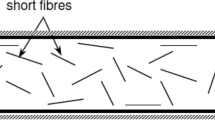Abstract
High-performance concrete and high-quality ordinary concrete, with or without silica fume, were tested for mechanical and fracture mechanical properties. Testing was performed at 28 days and 2 years. Ten percent silica fume resulted in a 20 to 25% increase in the direct tensile strength and a 10 to 20% increase in flexural and compressive strength, but had little effect on the dynamic modulus of elasticity. The brittleness appeared to increase with the presence of silica fume.
Résumé
Les propriétés mécaniques de la rupture ont été testées sur des bétons de hautes performances et sur des bétons ordinaires de haute qualité, avec ou sans fumée de silice. Les essais ont été effectués à 28 jours et à 2 ans. L’ajout de dix pour cent de fumée de silice a pour effet l’augmentation de la résistance en traction directe de 20 à 25% ainsi que l’augmentation des résistances en flexion et en compression de l’ordre de 10 à 20%, mais a peu d’effet sur le module d’élasticité dynamique. Par ailleurs, la fragilité du béton est accrue en présence de fumée de silice.
Similar content being viewed by others

References
Smeplass, S., Barkenæs, J. E. and Hansen, E. Aa., ‘Effect of the aggregate type on strength and fracture of high strength concrete’, Proceedings of the 3rd International Symposium on the Utilization of High Strength Concrete, Lillehammer, June, 1993 (Norwegian Concrete Association, Oslo,Vol. 2, 1993) 1225–1238.
Zhou, F. P., Barr, B. I. G. and Lydon, F. D., ‘Fracture properties of high-strength concrete with varying silica fume content and aggregates’,Cem. Concr. Res. 25 (3) (1995) 543–552.
Tasdemir, C., Tasdemir, M. A., Lydon, F. D. and Barr, B. I. G., ‘Effects of silica fumc and aggregate size on the brittleness of concrete’,Cem. Concr. Res. 26 (1) (1996) 63–68.
Kjellsen, K. O., Wallevik, O. H. and Hallgren, M., ‘On the compressive strength development of high-performance concrete and paste—effect of silica fume’,Mater. Struct. 32 (1) (1999) 63–69.
Kjellsen, K. O., Wallevik, O. H. and Fjällberg, L., ‘Microstructure and microchemistry of the paste—aggregate interfacial transition zone of high-performance concrete’,Adv. Cem. Res. 10 (1) (1998) 33–40.
Kjellsen, K. O. and Jennings, H. M., ‘Observations of microcracking in cement paste upon drying and rewetting by environmental scanning electron microscopy’,Adv. Cem. B. Mater. 3 (1) (1996) 14–19.
Kjellsen, K. O., Jennings, H. M. and Lagerblad, B., ‘Evidence of hollow shells in the microstructure of cement paste’,Cem. Concr. Res. 26 (4) (1996) 593–599.
Kjellsen, K. O., Jennings, H. M. and Lagerblad, B., ‘Hollow-shell formation—an important mode in the hydration of Portland cement’,J. Mater. Sci. 32 (1997) 2921–2927.
Kjellsen, K. O., Fjällberg, L. and Skjetne, T., ‘A quantitative analysis of the major phases in sulfate-resistant cement silica fume systems by SEM, 29Si NMR and XRD methods’, Report 2:97, Swedish Cement and Concrete Research Institute, Stockholm, 1997.
Kjellsen, K. O. and Helsing Atlassi, E., ‘Porestructure of cement silica fume systems: Presence of hollow-shell pores’,Cem. Concr. Res. 29 (1999) 133–142.
Byfors, J., ‘Plain concrete at early ages’, Report 3:80, Swedish Cement and Concrete Research Institute, Stockholm, 1980.
Nagy, A., ‘Cracking in reinforced concrete structures due to imposed deformations’, Report TVBK-1012, Lund Institute of Technology, Lund, 1997.
RILEM Draft Recommendation, ‘Determination of fracture energy of mortar and concrete by means of three-point bend test on notched beams’,Mater. Struct. 18 (1985) 285–290.
Cervenka, V. and Pukl, R., ‘SBETA, program documentation’, Cervenka Consulting, Prague, 1996.
Montgomery, D. C., ‘Design and analysis of experiments’, 2nd Edn., (John Wiley & Sons, New York, 1984).
Hilleborg, A., Modeer, M. and Petersson, P. E., ‘Analysis of crack formation and crack growth in concrete by means of fracture mechanics and finite element’,Cem. Concr. Res. 6 (1976) 773–782.
Handbook of Physics, Eds. E.U. Condon and H. Odishaw 2nd Edn, (McGraw-Hill, New York), 1967.
Chatfield, C., ‘Statistics for technology, a course in applied statistics’, 2nd Edn., (Chapman and Hall, London), 1978.
Hassanzadeh, M. and Haghpassand, A., ‘Brittleness of normal and high-strength concrete’, Proceedings of the 3rd International symposium on the Utilization of High Strength Concrete, Lillehammer, June, 1993 (Norwegian Concrete Association, Oslo,Vol. 2, 1993) 1092–1099.
Author information
Authors and Affiliations
Additional information
Editorial Note Dr. Olafur Wallevik is a RILEm Senior Member. He participates in RILEM TCs 145-WSM (Workability of special concrete mixes) and 174-SCC (Self-Compacting Concrete) as well as in RILEM TC 181-EAS (Early age shrinkage induced stresses and cracking in cementitious systems) as a Corresponding Member.
Rights and permissions
About this article
Cite this article
Kjellsen, K.O., Hallgren, M. & Wallevik, O.H. Fracture mechanical properties of high-performance concrete—Influence of silica fume. Mat. Struct. 33, 552–558 (2000). https://doi.org/10.1007/BF02480535
Received:
Accepted:
Issue Date:
DOI: https://doi.org/10.1007/BF02480535



